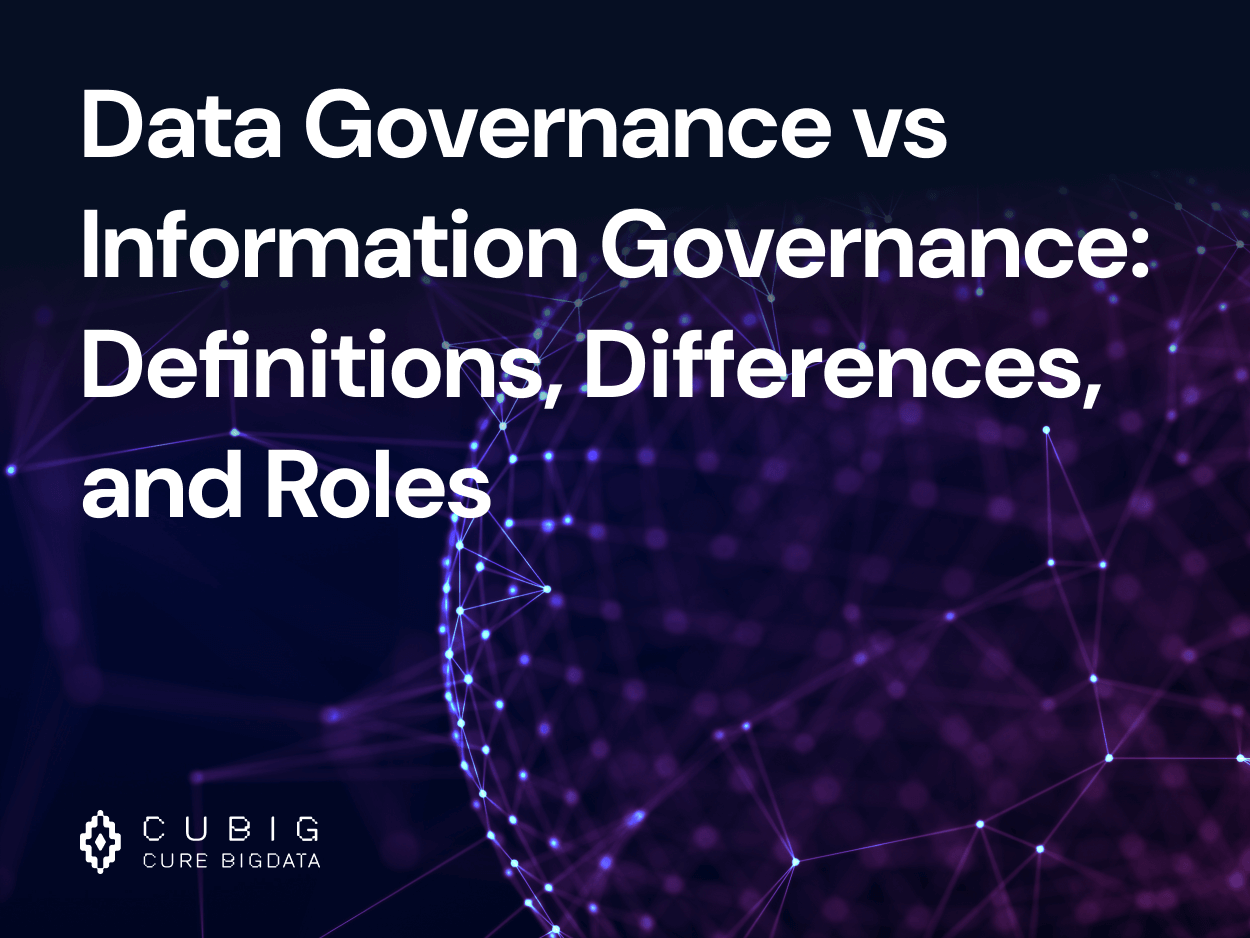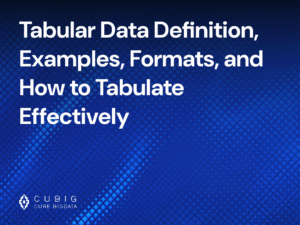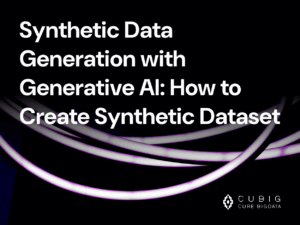Data Governance vs Information Governance: Definitions, Differences, and Roles
Table of Contents
What Is Data Governance vs Information Governance?
Definition of Data Governance
Data governance refers to the structured set of rules, roles, and processes that determine how data is handled throughout its lifecycle. This includes establishing standards for data quality, consistency, security, and access controls, ensuring that data is reliable, accurate, and usable across enterprise systems. It typically focuses on structured data—like customer records, transactional data, and system-generated logs—and guides how that data is entered, validated, stored, and shared across platforms. The goal is to maintain trust in data as a strategic asset that supports analytics, operations, and decision-making.
Definition of Information Governance
Information governance is a broader, more holistic discipline that governs all forms of information within an organization—whether structured (like database entries) or unstructured (like documents, emails, and videos). It includes data governance, but also addresses legal, ethical, and regulatory aspects of information management. Key components include records retention schedules, privacy and confidentiality policies, litigation hold procedures, intellectual property protection, and email archiving practices. Information governance ensures that information, in any form, is controlled and compliant with organizational policies and external legal requirements.
Why the Distinction Matters in Enterprise Contexts
Distinguishing between data governance and information governance helps organizations assign the right responsibilities, deploy appropriate technologies, and meet compliance obligations more effectively. For example, while a data governance team may focus on improving the accuracy of a customer database, an information governance team ensures that contracts, meeting notes, or chat messages related to that customer are retained, archived, or deleted according to legal and regulatory policies. Failing to recognize the broader scope of information governance can lead to unmanaged risks—such as untraceable documents during litigation or unretained communications in regulated industries. Clear boundaries between the two enable better risk management, transparency, and accountability across business units.
Data Governance vs Information Governance: Side-by-Side Comparison
Scope, Objectives, and Policy Orientation
Data governance primarily focuses on ensuring the quality, consistency, and accessibility of structured data within business systems. It is often led by data management and IT teams in collaboration with business units, and supports goals like analytics accuracy, operational efficiency, and AI readiness. Information governance expands this scope by including content types such as documents, emails, video recordings, spreadsheets, and even paper records. It places a stronger emphasis on compliance, legal defensibility, ethical handling of information, and organizational knowledge management. Where data governance policies govern who can access a database field and how that data is validated, information governance defines how long an email should be retained, who can share a document externally, and how communications are archived for legal discovery.
Stakeholders Involved and Their Responsibilities
Data governance typically involves data stewards, IT professionals, data architects, and business analysts. These stakeholders are responsible for defining data standards, managing metadata, ensuring data quality, and maintaining access controls. Their work ensures that structured data assets are reliable and accessible for business operations and analytics. Information governance, on the other hand, brings in broader roles—including legal counsel, records managers, privacy officers, compliance leaders, and executive sponsors. These stakeholders focus on legal risk, retention policies, data privacy, and ethical information use across all content types. Their goal is to ensure that enterprise information practices align with regulatory requirements, litigation readiness, and corporate accountability.
Technology vs Policy-Driven Governance
Data governance is often executed through technology solutions such as data quality tools, master data management (MDM) platforms, lineage tracking systems, and data catalogs. These tools help enforce consistency, accuracy, and access control for structured datasets across platforms. In contrast, information governance is more policy-driven, grounded in legal frameworks like GDPR, HIPAA, or SOX. It is implemented through enterprise content management (ECM) systems, email archiving platforms, and compliance automation tools. While data governance focuses on technical enforcement, information governance ensures that organizational information—structured and unstructured—is used, retained, and disposed of in accordance with laws, internal policies, and ethical standards.
How They Complement Each Other in Data Strategy
Data Governance as the Foundation
Strong data governance provides the structural integrity and reliability needed for effective information management. It ensures that the raw data flowing into systems is complete, accurate, and well-documented—forming a trusted foundation for business intelligence, regulatory reporting, and enterprise applications. Without well-governed data, information systems can become fragmented, unreliable, or even non-compliant, especially when feeding into records systems, dashboards, or AI pipelines.
Information Governance for Legal and Regulatory Scope
Information governance extends data governance by applying legal and compliance oversight to the full range of enterprise content. This includes managing email retention, legal holds, policy enforcement, and privacy controls across collaborative environments like SharePoint, Google Workspace, or Slack. It ensures that not just the data, but the context, communications, and documents surrounding it are properly preserved, classified, and auditable—supporting transparency, regulatory audits, and risk mitigation.
Unified Frameworks in Large Organizations
Large enterprises benefit from bringing both governance approaches into a unified framework. This involves aligning data management standards with content governance requirements under shared principles and joint KPIs. For example, data classification rules used by data governance can feed directly into information governance retention policies. Integrated platforms—such as those combining MDM, ECM, and compliance tooling—help enforce consistency across data and content assets. Establishing joint ownership between data stewards and records managers, supported by executive buy-in, helps bridge technical and legal functions. This convergence enables scalable, compliant, and agile information ecosystems.
Related Terms Compared
Data Governance vs Data Stewardship
Data stewardship is an operational role within the broader framework of data governance. While data governance defines policies, standards, and ownership models, data stewards are responsible for implementing those policies on a day-to-day basis. Stewards ensure that data quality is maintained, metadata is accurate, and access rules are followed. For example, if governance dictates that customer names must follow a standard format, stewards make sure that data entered into systems adheres to that format. Stewardship translates governance policy into operational reality and acts as the first line of quality assurance within business units.
Data Governance vs Data Security
Data security focuses on protecting data from threats—such as unauthorized access, breaches, and data loss—through technical means like encryption, firewalls, authentication, and monitoring. Data governance, by contrast, sets the policies and controls that define who should have access, what data is sensitive, and under what conditions it can be used or shared. While governance defines the “who” and “why,” security enforces the “how” using technical solutions. The two must work together: governance without security is unenforceable, and security without governance can become overly restrictive or misaligned with business needs.
Data Governance vs Data Analytics
Data analytics is the process of examining data to generate insights, detect patterns, and support decision-making. It relies heavily on clean, reliable, and well-documented data. Data governance provides the foundation for trustworthy analytics by ensuring that data is accurate, consistently defined, and compliant with privacy or regulatory requirements. Governance also manages data lineage, making it possible to trace how data was created, transformed, and used in analytical models. In short, analytics creates value from data, while governance ensures that data is fit for that purpose.
Data Governance vs Information Management
Information management refers to the lifecycle control of all types of information—structured and unstructured—including its creation, storage, retrieval, distribution, and eventual disposal. It emphasizes efficiency, accessibility, and system performance. Data governance, meanwhile, focuses on setting the rules and accountability structures for how that information should be handled. This includes policies for data access, quality, classification, and compliance. Information management executes processes; data governance defines how those processes should be structured and controlled. Both are essential and work best when aligned under a unified information strategy.
Data Governance and Information Governance Examples
Example 1: Customer Data Accuracy vs Retention Policy
Data governance ensures that customer contact data—such as phone numbers, email addresses, and billing information—is accurate, consistently formatted, and synchronized across CRM, billing, and marketing systems. This includes implementing validation rules and data stewardship responsibilities. In contrast, information governance addresses the legal and regulatory policies surrounding the lifecycle of that data. For example, it defines how long customer records must be retained under data privacy laws (like GDPR or CCPA), and when those records should be purged or archived in accordance with compliance rules.
Example 2: Access Control vs Email Archiving Rules
Data governance focuses on controlling access to structured systems like customer databases. It defines role-based permissions that limit which employees or departments can view or edit sensitive customer data. These rules are enforced through IAM (identity and access management) systems. Information governance, on the other hand, addresses how communications—such as emails related to customer complaints—are retained and archived. This includes defining email retention schedules, auto-archiving rules, and compliance with industry regulations that require preserving certain communications for audit or legal purposes.
Example 3: Metadata Management vs Legal Hold Procedures
Within a data governance framework, metadata management involves tagging data assets with business context, such as data source, owner, sensitivity level, or update frequency. These tags help ensure discoverability, data lineage, and usage clarity across systems. Information governance extends control to legal and regulatory scenarios. For instance, when a lawsuit is anticipated or in progress, it activates legal hold procedures. These prevent the deletion of relevant files, emails, or records—ensuring that potentially critical information is preserved and auditable in legal discovery.
Example 4: Role-Based Permissions vs Executive Oversight
Data governance defines and enforces access controls for financial data through structured permission groups—for example, allowing only finance analysts to view forecast models, while limiting editing access to senior controllers. Information governance adds an executive layer of accountability. It ensures that data policies—such as those affecting financial reporting, audit trails, or earnings disclosures—are reviewed and approved by senior leadership or compliance officers. This protects against reputational and regulatory risk in high-stakes data environments.
How Azoo AI Supports Governance Frameworks
Azoo AI bridges both data governance and information governance by enabling secure synthetic data generation, structured integration, and validation across enterprises. With tools like DTS for private synthetic data, SynFlow for integration without data exposure, and SynData for regulatory-grade validation, Azoo AI supports policy enforcement at every step. Moreover, with LLM Capsule and DataXpert, Azoo AI ensures safe use of public LLMs and provides natural language analytics with governance-friendly access controls.
Benefits of Differentiating and Aligning Both Governance Models
Clarity in Responsibility and Risk Mitigation
Differentiating between data governance and information governance allows organizations to clearly define who is responsible for which aspects of governance. For instance, data stewards may focus on data quality and access control, while records managers handle retention and legal compliance for documents and communications. This role clarity reduces overlap and avoids gaps in enforcement, which in turn helps mitigate risks such as policy violations, unauthorized access, or non-compliance with regulatory mandates. It also streamlines issue resolution by ensuring that every governance area has a designated owner.
Improved Regulatory Readiness
With both governance models implemented and aligned, organizations are better positioned to respond to evolving regulations such as GDPR, HIPAA, CCPA, and industry-specific mandates. Data governance provides the technical infrastructure—such as access logs, quality metrics, and lineage trails—while information governance ensures that retention, privacy, and documentation policies align with legal expectations. This dual-layered approach strengthens audit readiness and improves the organization’s ability to demonstrate compliance under scrutiny from regulators or external stakeholders.
Better Decision-Making Through Structured Policies
When data and information governance are coordinated under a unified policy framework, decision-makers gain full visibility into the organization’s digital assets. Consistent metadata, clear ownership, and shared definitions make it easier for leaders to interpret reports, trust analytical models, and act on data confidently. This leads to faster, more informed decisions across departments—from operational planning and risk assessment to strategic investments and regulatory disclosures.
Streamlined Communication Between Legal, IT, and Business Units
Aligning both governance models fosters collaboration among diverse teams that traditionally operate in silos. Legal departments benefit from IT’s transparency on data handling practices; IT gains clarity on legal requirements; and business teams are empowered with secure, governed access to the data they need. This integrated communication model enhances policy enforcement, reduces friction in cross-functional projects, and creates a culture of shared accountability for data and information governance.
Challenges in Applying Both Frameworks
Organizational Silos and Role Confusion
In many enterprises, departments such as legal, IT, compliance, and business operations operate with different goals, vocabularies, and priorities. This siloed structure makes it difficult to implement unified governance strategies. Without clearly defined roles and responsibilities, teams may either duplicate efforts or leave critical tasks unassigned. For example, legal may assume IT handles data retention, while IT expects legal to define the requirements—resulting in a gap. Establishing cross-functional governance councils and clear RACI (Responsible, Accountable, Consulted, Informed) models is essential to overcoming this challenge.
Overlapping Tools or Frameworks
Organizations frequently implement separate tools for data governance (e.g., data catalogs, lineage trackers) and information governance (e.g., records management, e-discovery platforms). These systems may not communicate effectively, leading to disconnected policies and inconsistent enforcement. This lack of integration creates redundancy, increases licensing and maintenance costs, and can cause policy misalignment. For example, data may be deleted from a system due to an automated data policy, while still under legal hold per an information governance rule. Unified or interoperable platforms are critical to ensure holistic policy execution.
Scaling Across Global Entities
Large enterprises operating in multiple countries face added complexity when applying governance frameworks. Each region may have its own data privacy laws, cultural expectations, and technology environments. Ensuring that policies like data access, retention, and consent are applied consistently—while also respecting local legal nuances—can be challenging. For example, data localization laws in one country may conflict with centralized data processing strategies. Scalable governance requires flexible architectures, regional policy overlays, and governance teams with global awareness.
Keeping Up With Changing Regulations
The regulatory landscape is constantly evolving, with new privacy laws, data handling rules, and compliance standards emerging globally. Laws like GDPR, CCPA, HIPAA, and sector-specific mandates often change with little notice. Organizations must not only monitor these changes but also update internal policies, reconfigure systems, and retrain staff in a timely manner. Without agile governance frameworks, compliance gaps may emerge—resulting in legal exposure, reputational damage, or operational disruption. Building adaptive governance models that include legal monitoring, version-controlled policy management, and automated rule deployment helps address this ongoing challenge.
FAQs
What is the main difference between data governance and information governance?
Data governance refers to the technical and operational management of structured data—such as customer records, transactions, or product data—through standards, quality controls, and access policies. Information governance takes a broader view, encompassing all forms of organizational information, including unstructured content like emails, documents, chat logs, and records. It emphasizes legal compliance, retention policies, and risk management. In essence, data governance focuses on the “how” of data control, while information governance focuses on the “why” of information responsibility across the business.
Do organizations need both frameworks?
Yes, both are essential. Data governance ensures that data is accurate, accessible, and secure—serving as the foundation for analytics and operations. Information governance ensures that the broader content landscape meets legal and regulatory expectations. Without data governance, analytics and automation may fail due to poor data quality. Without information governance, organizations may face legal exposure from mismanaged communications or records. Together, these frameworks create a holistic, compliant, and high-functioning data environment.
How do governance models impact compliance?
Governance models provide the structure and oversight needed to align data handling with internal policies and external regulations. Data governance contributes by maintaining data integrity, controlling access, and ensuring traceability—key for audit readiness. Information governance supports compliance by managing document retention, enforcing privacy policies, and maintaining legal defensibility in case of litigation or investigation. Both are critical for meeting standards like GDPR, HIPAA, CCPA, SOX, and ISO 27001.
Is information governance more legal-focused?
Yes. While data governance is often led by IT and business operations, information governance is typically driven by legal, compliance, and risk teams. It focuses on regulatory alignment, legal holds, retention schedules, and ethical handling of sensitive content. This includes not just data, but emails, contracts, reports, and other records that may be subject to external scrutiny or internal policy. Information governance ensures that all business communications and documents are properly managed, discoverable, and defensible when needed.
How can Azoo AI assist in governance implementation?
Azoo AI supports governance implementation by enabling secure synthetic data workflows. DTS helps generate high-quality, privacy-safe synthetic data that complies with internal standards. SynFlow allows organizations to integrate data across teams without exposure risks, and SynData delivers validation reports that prove regulatory compliance. DataXpert makes it easy for users to explore and analyze data using natural language while staying within governance controls. These tools work together to streamline governance across both structured and unstructured data environments.
CUBIG's Service Line
Recommended Posts









